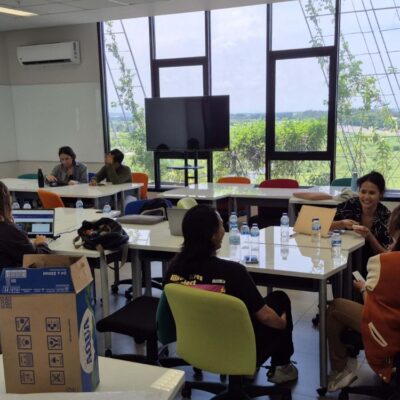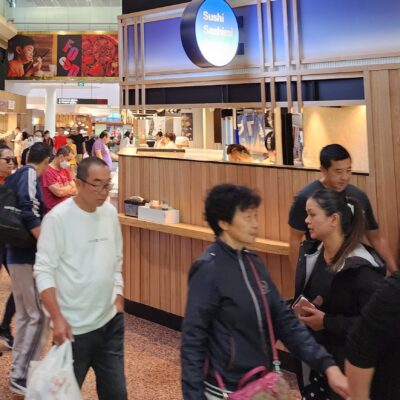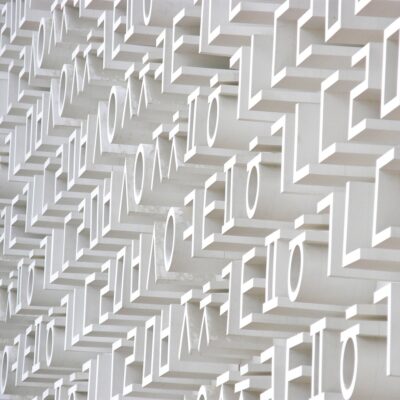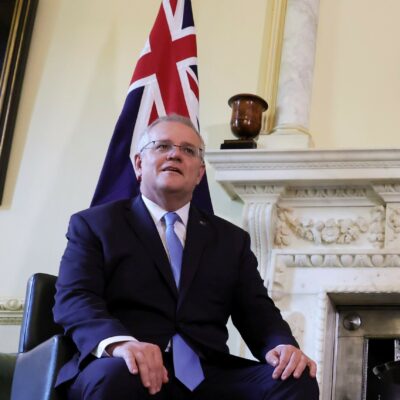Approximately 3,600 South Korean children have been adopted to Australia since 1969, making them the largest cohort of intercountry adoptees in Australia. Referred to by demographers as the ‘quiet’ or ‘unknown’ migration, transnational or intercountry adoption has tended to sit uneasily within, and has sometimes been excluded from, accounts of migration.
Research suggests that South Korean adoptees inhabit and negotiate multiple social positions and identities. There remain relatively few studies that focus specifically on the experiences of Korean-Australian adoptees, their connections to South Korea, and engagements with Korean adoptee culture. This article argues that the notion of ‘hometactics,’ theorised by feminist philosopher Mariana Ortega, is a useful concept for understanding the various ways in which adopted Korean Australians navigate being ‘in between’ worlds.
Intercountry adoption to Australia
South Korean (hereafter Korean) international adoption began in the aftermath of the Korean War (1950-53) and was characterised as a humanitarian response to the plight of thousands of orphaned children. The first ‘wave’ or ‘generation’ of Korean adoptees were adopted by families in the US and Western Europe. While adoption as a practice has a long history that predates the mid-1950s, post-war Korean adoption has been recognised as pivotal in establishing the modern intercountry adoption system. Intercountry or transnational adoptions are predominantly transracial; that is, children are adopted both ‘across’ national borders and ‘across’ race and ethnicity. The majority of Korean adoptees are adopted by white families and grow up in predominantly white communities.
Intercountry adoption is a complex phenomenon involving various institutions, laws, and policies in both ‘sending’ and ‘receiving’ countries. As with other forms of migration, official intercountry adoption to Australia relies on federal immigration policy and state authorities for its facilitation. In addition, there are various international standards and safeguards (including the 1989 UN Convention on the Rights of the Child, and the 1993 Convention on Protection of Children and Co-operation in Respect of Intercountry Adoption) which have considerable moral influence, but often lack enforceability.
Intercountry adoption in Australia also formally began in the context of war and militarism, with ‘Operation Babylift’ at the end of the Vietnam War in April 1975. The adoptions of Vietnamese children by Australian couples occurred around the same time as domestic adoption rates were declining, and domestic transracial adoption practices were facing public condemnation in Australia and the US. As studies by scholars Joshua Forkert and Patricia Fronek have shown, the media played a substantial role in shaping how international adoption became viewed as a humanitarian solution to children in crisis. Fronek charts how the Australian interest in adoption quickly ‘transferred from Vietnamese to Korean children.’ In December1977, the first official Korean adoptees arrived: eight infants were flown to New South Wales.
It is important to note that, as with the adoption of Vietnamese children, Korean children were being adopted by Australian families prior to the formal establishment of intercountry adoption programs. Indeed, from the late 1960s to mid-1970s, government officials and social workers faced mounting public pressure from parents’ groups to help with the facilitation of overseas adoption. Several Vietnamese and Korean children adopted by Australian parents were unable to enter Australia because the Australian Immigration Department was reluctant to issue visas. This pressure from adoptive parents’ associations also took place in the context of changing international norms regarding racially discriminatory immigration policies, and the unravelling of Australia’s White Australia immigration policy which had been decades in the making.
The Korean transnational adoption program
Despite its origins as a putatively temporary measure in the aftermath of war, and several policies designed to phase out the practice, Korean transnational adoption continues. Korean Australian adoptees comprise a small percentage of the estimated 180,000 Korean children adopted to Western countries since the Korean War armistice agreement. The first ‘generation’ of Korean adoptees were mixed-race children of Korean mothers and US and European military personnel. By the 1980s, the vast majority of adoptees were of so-called ‘full’ Korean parentage, born to unmarried mothers, and categorised as ‘illegitimate.’ Researchers estimate that upward of 120,000 Korean overseas adoptees were born to single mothers.
By the time Korean adoption to Australia formally began, approximately 37,000 South Korean children had been adopted to the US and western European countries. The immediate post-war period was over, and South Korea was rapidly industrialising under the authoritarian regimes of Park Chung Hee (1961-1979) and Chun Doo Hwan (1981-1987). Korea had implemented several programs and laws that led to the growth and systemisation of overseas adoption, including the 1961 Orphan Adoption Special Law, which established the legal framework for its international adoption program, and the 1962 Family Planning Program, which incentivised couples to restrict the number of children they had. Under President Chun, adoption was deregulated and explicitly cast as part of South Korea’s emigration expansion and ‘a good-will ambassador’ policy. Meanwhile, fertility rates in the West were declining, as was the availability of healthy infants for domestic adoption. Transnational, transracial adoption was increasingly viewed as a legitimate mode of family formation.
Korean adoption to Australia has generally followed global trends, reaching its peak in 1985 and 1986. Roughly 600 Korean children were adopted to Australia during these two years. Faced with international condemnation of their overseas adoption program during the 1988 Seoul Olympics, South Korea implemented a gradual phasing out of the program, initially intending to cease operations by 1996. Overseas adoption rates declined to roughly 2,000-2,200 children per year during the early to mid-1990s. Due to the International Monetary Fund crisis of 1997-1999, and revised plans to phase out overseas adoptions by 2015, adoption rates increased in the late 1990s and early 2000s. They have since declined.
South Korea was the main nation of origin for intercountry adoptions to Australia between 1991-2003 and re-emerged as the primary nation of origin in 2018-2019. According to reports from the Australian Institute of Health and Welfare, the total number of South Korean adoptions is more than double that of adoptions from China, the second major sending country to Australia.
Transnational adoption as ‘quiet’ migration
Richard Weil and several other researchers have referred to transnational adoption as the ‘quiet’ or ‘unknown’ migration. A multi-dimensional phenomenon, transnational adoption has proven challenging to situate within migration studies. Accurate global intercountry adoption figures are difficult to obtain. Ethnic and migration studies rarely include adoptees, since ‘adoption is not really conceptualised as a migration.’ It is typically overlooked because adoption involves infants or children, the ‘littlest immigrants’, and is understood primarily as a form of modern family creation. In ‘receiving’ countries, adoption tends to be highly individualised and regarded as a private affair, rather than a nationally-regulated, group-based movement of people across borders.
Transnational adoption practices and adoptees’ migration histories result in cultural characteristics that differ from those of other Korean migrants. Unlike first generation migrants, adoptees do not arrive with Korean language capacity, and if they do, this is usually considerably diminished within a couple of years. Most lack memory of, and material belongings from, their pre-adoptive (or pre-immigration) pasts. Since full adoption entails legal severance from birth family, and adoptability in Korea requires orphanhood, adopted Koreans do not have access to pre-adoption relationships. Furthermore, while they may share certain characteristics with second or third generation migrants—for instance, having English as their ‘native’ language and negotiating ‘Koreanness’ and being Australian—they were not raised in families that share their migration experiences and/or experiences of racism.
As ‘quiet’ migrants, adoptee infants and children quickly adjust, and are integrated into, their adoptive families and communities. As Korean adoptee Beth Kyong Lo writes in the anthology Outsiders Within: ‘my immigration was quiet and Anglo-sized. First generation turned third.’ Indeed, a key dimension of the transracial adoption experience, expressed in adoptee texts and explored in scholarly research, is what is known as the ‘transracial adoption paradox’. Theorised by psychologist Richard M. Lee, the paradox refers to the ‘contradictory’ experiences undergone by racial minority children adopted by white parents: transracial adoptees are ‘racial/ethnic minorities in society, but they are perceived and treated by others, and sometimes themselves, as if they are members of the majority culture (i.e., racially White and ethnically European).’ Studies have shown that many Korean adoptees viewed themselves as white when they were young, and tended to minimise their racial and ethnic differences from their peers. Transracial, transnational adoptees inhabit and negotiate a social positioning that generates experiences that differ from those of other migrants.
The Korean adoptee diaspora: connections, returns
As studies increasingly focus on adult adoptees, departing from earlier preoccupations with adoptee children and adjustment, connection to Korea, searching for Korean family (also referred to as birth family or original family), adoptee communities and activism, experiences of racism, as well as adoptees’ dynamic and multiple identities, have emerged as salient themes. Since the 1990s there has been a steady proliferation of adoptee-authored texts including anthologies, scholarly books, poetry, memoir, blogs, film, and art projects, which shed light on those aspects of adoptees’ lived experiences that are of particular significance to them.
Since the late 2000s several surveys funded by the South Korean Ministry of Health and Welfare provide valuable insights into adoptees’ connection to Korea, and desire and commitment to search for Korean family. These surveys targeted Korean adoptees worldwide (Australian adoptees were included in small numbers).
Results showed that adoptees have a significant interest in Korea, with approximately 80 percent of respondents having visited Korea an average of 3-4 times since their adoption. The F-4 visa, extended to adoptees in 1999, provides pathways for adoptees to remain and work in Korea for extended periods. It is estimated that 3,000-4,000 adopted Koreans visit each year, and a small number choose to return to live. It is unknown how many Australian adoptees are included in these groups, but it is likely that these numbers will increase in the coming years.
A 2013 survey published by the Korea Institute for Health and Social Affairs (KIHASA) found that approximately 80 percent of respondents expressed the desire to find their birth families, with adoptees in their 30s the most likely to have attempted to search for them. Interest in initiating family searches has been known to increase as adoptees reach adulthood. Among those who were successful, the average time it took to find birth family was 50 months, with adoptees from Australia, Canada, and other non-US and non-European countries, having the longest waiting period (88 months). Support for family searches and reunions was deemed the most needed Korean government post-adoption service.
Consistent with numerous qualitative studies which focus on specific receiving countries, these worldwide surveys also found that experiences of racial discrimination in adoptees’ adoptive countries were common, as was ambiguity with regard to identity and belonging. Conducted in partnership with the adoptee-run organisation Global Overseas Adoptees’ Link (GOA’L), a 2011 survey found that those with a strong ‘adoptee identity’ generally reported better mental health outcomes than those with weak adoptee identity; and this was the case even among those who identified strongly with being Korean. While this is not a generalisable finding, it does highlight ‘adoptee identity’—linked to, but which cannot be easily conflated with ethnic, racial, and national identity.
On the whole, Korean Australian adoptees are considerably younger than their US-based and European counterparts. Due to fluctuations in adoption rates and age at adoption, the largest cohorts of Korean adoptees in Australia are now in their mid-30s or mid to late teens, while many in the US, Norway, and Sweden are now in their late-60s. Since 1986, with the founding of Adopterade Koreaners Förening in Sweden, numerous adult Korean adoptee-run organisations around the world have been established that provide resources and support. The Korean Adoptees in Australia Network, the first Korean adoptee-run organisation in Australia, was founded in 2014.
‘I’m the same but I’m not’: dynamic and multiple identities
While there are a handful of studies that focus on Australian intercountry adoptee experiences more broadly, and an established field of Korean adoption studies in the US, there remains a relative dearth of research that focuses specifically on adult Korean Australian adoptee experiences. A few in-depth, qualitative studies constitute the bulk of the existing research, and focus on Korean adoptees’ dynamic and fluid cultural, racial, and ethnic identities and engagements with transnational adoptee communities and networks.
Many Australian Korean adoptees have grown up in social environments which are, compared to those of earlier generations of adoptees, more ethnically and racially diverse. However, HeeRa Heaser’s investigation of Korean Australian adoptee diasporas (the only study that focuses solely on Australian adoptees) found that experiences of racism were common, and that many faced challenges growing up in contexts where being Australian was synonymous with being white. Foregrounded is the experience of ‘looking’ one way (Korean) but ‘feeling’ another: ‘the same as a White Australian.’ The contradictory experiences arising from the transracial adoption paradox are expressed, Heaser concludes, in participants’ multiple and ambiguous identities: ‘I’m Australian but I’m not – I’m Korean but I’m not – I’m White but I’m not – I’m Asian but I’m not – I’m the same but I’m not.’
Other studies also highlight the ambiguity and fluidity of Korean Australian adoptee identifications, and how making sense of adoptee belonging is a lifelong experience. Adoptees often describe feeling ‘in between’ worlds, not belonging completely to either their adoptive country or to Korea. Their identifications, and the salience of particular aspects of their identities, are highly dependent on context: on where they are, who they are with, and what they know of their histories. Upon visiting Korea, as studies by Elizabeth Goode and Jessica Walton demonstrate, Australian adoptees are often confronted by the feeling of ‘coming home’ and yet ‘not fitting in.’ Being in Korea, on a corporeal level, has a significant impact on identity, as Walton argues, because sense-making is a bodily process. As one of Walton’s interviewees explained:
‘Even though I haven’t fully figured out who I am, just going to Korea, just being where it all started does something…there’s something about just being there physically and seeing it. Seeing with your own eyes where you came from, standing there with your own feet, smelling, hearing, tasting, touching. All of that does something in helping me discover a little more about myself.’
As mentioned above, significant numbers of adoptees have visited Korea, many making multiple trips. In addition, social media and the increased accessibility of Korean culture and language learning opportunities, provides ample pathways for Korean Australian adoptees to explore their connections to Korea, as well as to fellow adoptees. Heaser’s study on Korean Australian adoptee diasporas analysed participants’ engagements with Korean adoption-related social media, and found that social media, Facebook, in particular, constitutes a significant digital diasporic site for the production and maintenance of transnational adoptee communities. Further in-depth research is required on the longer-term impacts of Australian adoptees’ return trips, engagements with the Korean adoptee diaspora, and connections to Korea.
Korean adoptee culture and ‘hometactics’
‘I identify as American. But my culture, I mean, the culture I identify [with] is Korean adoptee. It’s not Korean American. Because Korean American is not what I am. Because I have, there’s a different culture. Because all of us adoptees have basically white culture, but we have an Asian face. And that’s a whole culture unto itself, complete with its own prejudices and issues and marginalization. We’ve experienced the same history. And you can’t compare that to being Korean American, you know’ – KIHASA survey respondent [italics added].
As with other migrants, what is important is not only where one has come from, and how one has got there, but also how one is and lives, where one is. To understand, in other words, everyday ways of living with and negotiating one’s social positioning in the present. What does it mean or feel like to be ‘in between’? Where are you, when you are in between worlds? And how do you live this ‘in betweenness’?
Feminist phenomenologist Mariana Ortega’s concept of ‘hometactics’ is useful here, as she emphasises the ways in which every day, creative practices of ‘making do,’ provide a sense of belonging for individuals navigating worlds that do not feel completely ‘homely.’ Importantly, Ortega writes of a home which avoids notions of authentic belonging (which always enacts exclusion), remains alert to the ‘trappings’ of romanticised home, and which relinquishes the possibility of ‘full’ or complete belonging. She introduces ‘hometactics’ to emphasise that ‘home’ always involves a doing, activity—hence drawing attention to ways of doing, modes of living with ambiguity.
This allows us to move away from the question of where so-called ‘real’ or authentic home is, of where one completely belongs, to: how do you make home, wherever you are? Less about fixed spatiality, and more about the ‘getting by’ or the ‘making do’. What is key is modes of cultivating familiarity and (re)inhabiting place in a way that may continue to feel uncomfortable, but which is nonetheless a way of continuing to be. Adoptees negotiate multiple social positions and identities, which throw up various ‘ambiguities and contradictions.’ They engage with such ambiguities in a practical way, and through everyday practices forge a sense of belonging, however provisional and open to change. ‘Making do’ is hence to live with and through one’s “multiple identities,” one’s ‘being-between-worlds, with all the privileges and disadvantages, losses and longings, and the liminality that comes with this.
For writer and adoptee Sunny Jo, ‘feelings of alienation’ and the sense of ‘having no home’ has contributed to the development of Korean adoptee culture and what she calls ‘KAD Nation.’ There are now multiple ‘generations’ of adopted Koreans around the world, and many adopted Koreans are now parents and grandparents themselves. As the quote at the start of this section suggests, Korean adoptee culture has been built on and around the creative rendering of adoptees’ opaque origins and specific migration experiences into cultural forms that serve as bases for connection. Indeed, Korean adoptees have for several decades now generated diasporic texts including art, literature, theatre, and film, and contributed to adoption and Korean studies research. As with any large group, their perspectives, experiences, interests, and identities are varied and diverse.
Ortega asserts that writing as a philosopher in an academic environment and discipline ‘that was never meant to be a home for me – this is one of my hometactics.’ Visiting or living in Korea as part of the Korean adoptee diaspora, reading, writing, researching, learning, connecting—there exists a multitude of ‘hometactics’, an array of ways in which ‘in betweenness’ is lived.
Research on Korean Australian adoptee ‘hometactics’ is a promising avenue to pursue, in light of increased opportunities to visit and live in Korea, connections to adoptee networks, searches for Korean family, as well as exposure, and contributions to, Korean adoptee culture. Building on the important work of scholars including Heaser, Goode, and Walton, this in-depth research would extend our understanding of this often-overlooked subset of the Korean Australian community, and Asian Australian population more broadly.
Image: Lotus lantern festival, Seoul. Credit: Vincent G.H. Choi/Flickr.




